Young hybrid of cucumbers "Herman" for greenhouses and open ground
Hermann f1 cucumbers are an ultra early ripening Dutch hybrid that bears fruit in protected soil until late autumn. The greens of this crop do not accumulate bitter substances, have a pleasant sweetish taste and a pronounced aroma. The culture is characterized by low maintenance and consistently high productivity.
From the article you will learn about the nuances of hybrid agricultural technology, its pros and cons, measures to prevent fungal diseases and methods of controlling insects.
Description of the hybrid
Cucumber Herman f1 - a hybrid from Dutch biologists from Monsanto. Included in the State Register of the Russian Federation in 2001. Designed for cultivation in open ground, greenhouses and greenhouses.
The culture is characterized by early ripening, has a female type of flowering (parthenocarpic), therefore does not require additional pollination. Fertilization occurs without the participation of male cells. The formation of ovaries is fascicular. Such plants need to be shaped into bushes.
In the photo - hybrid Herman.
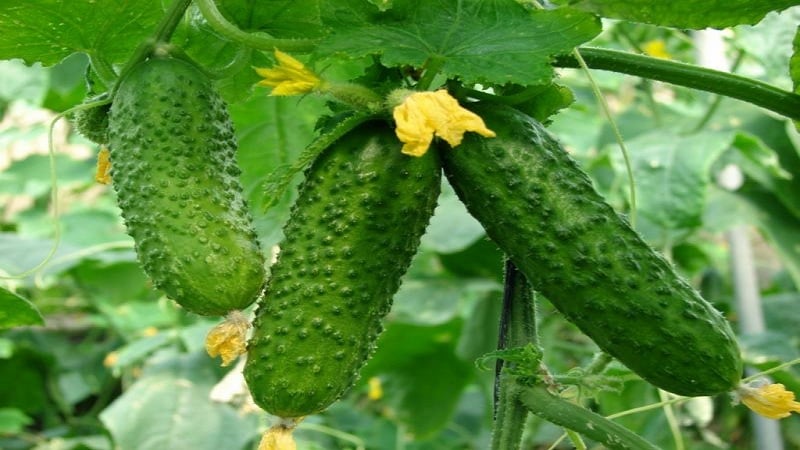
The table shows the main characteristics of cucumber.
| Indicators | Characteristic |
| Ripening period | 36-40 days from the moment of germination |
| Pollination type | Parthenocarpic |
| Weight | 70-90 g |
| Length | 10-11 cm |
| Form | Cylindrical, ribbed |
| Coloring | Green and dark green with short stripes and slight spotting |
| Leaves | Medium size, green and dark green color |
| Pulp | Medium density, sweetish |
| Taste | Excellent, no bitterness |
| Skin | Medium density, medium lumpy with white spines |
| Purpose | Universal |
| Productivity | 8-9 kg/m² |
| Sustainability | To cladosporiosis, cucumber mosaic virus, powdery mildew |
| Transportability | High |
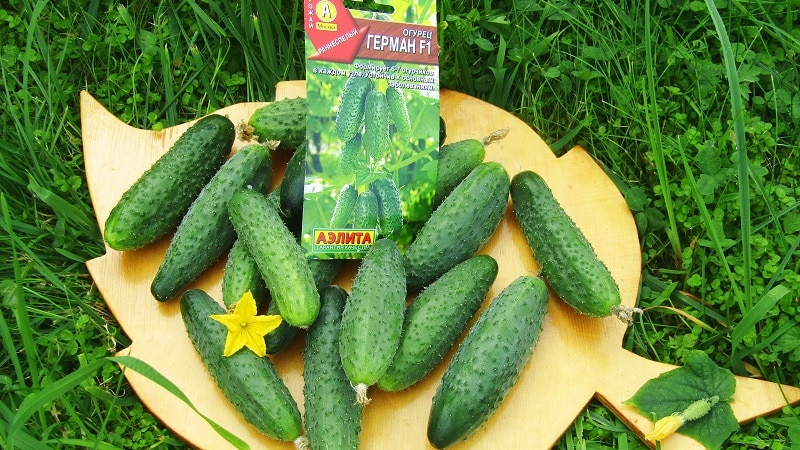
Composition, calorie content and benefits
Nutritional value of cucumbers (per 100 g):
- calorie content – 14 kcal;
- proteins – 0.8 g;
- fats – 0.1 g;
- carbohydrates – 2.5 g;
- water – 95 g;
- fiber – 1 g.
Table of vitamin and mineral composition.
| Vitamins | Minerals |
| Vitamin A | Calcium |
| Vitamin B1 | Silicon |
| Vitamin B2 | Potassium |
| Vitamin B4 | Sodium |
| Vitamin B5 | Magnesium |
| Vitamin B6 | Sulfur |
| Vitamin B9 | Phosphorus |
| Vitamin C | Chlorine |
| Vitamin E | Iodine |
| Vitamin H | Iron |
| Vitamin K | Manganese |
| Vitamin PP | Selenium |
| Copper | |
| Chromium | |
| Fluorine | |
| Zinc |
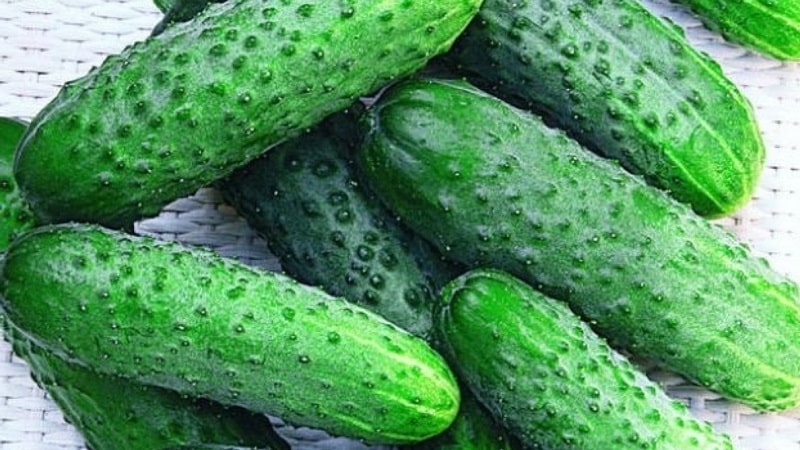
Benefits of cucumbers:
- normalization of water and electrolyte balance;
- relief from heartburn;
- replenishment of mineral and vitamin deficiencies;
- improvement of digestive function;
- normalization of the thyroid gland;
- removing excess fluid from tissues;
- lowering cholesterol levels;
- freckle whitening.
Agricultural technology for cucumbers
Hybrid Herman grown mainly by seeding due to poor tolerance of the transplant. The seedling method can be used when sowing in a 0.5 liter container.
When grown in the garden seeds are sown at the end of May, and seedlings are planted in early June. Sowing work in the greenhouse begins in the first ten days of May.
Caring for cucumbers comes down to frequent watering, fertilizing, loosening and weeding of the soil.
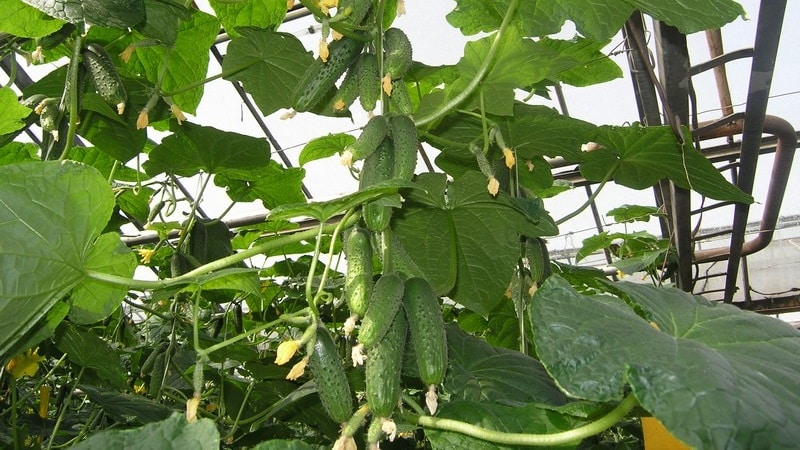
Planting by seed
Direct sowing of seeds into the ground is carried out at the end of May or beginning of June. The air should warm up to a temperature of +20 °C, the soil - to +12 °C.
Cucumbers “love” loose and fertile soil. In autumn, the site is dug up and fertilized with humus (10 l/1 m²). In spring, loosen and add:
- 10 liters of humus;
- half a bucket of peat;
- half a bucket of river sand;
- 20 g superphosphate;
- 20 g of potassium nitrate;
- 20 g ammonium nitrate.
Sowing pattern – 30x60 cm. Seed depth – 1.5-2 cm. Two grains are placed in each hole, with the nose at the bottom. After sowing, the beds are mulched with compost, sawdust, straw, hay or black agrofibre.
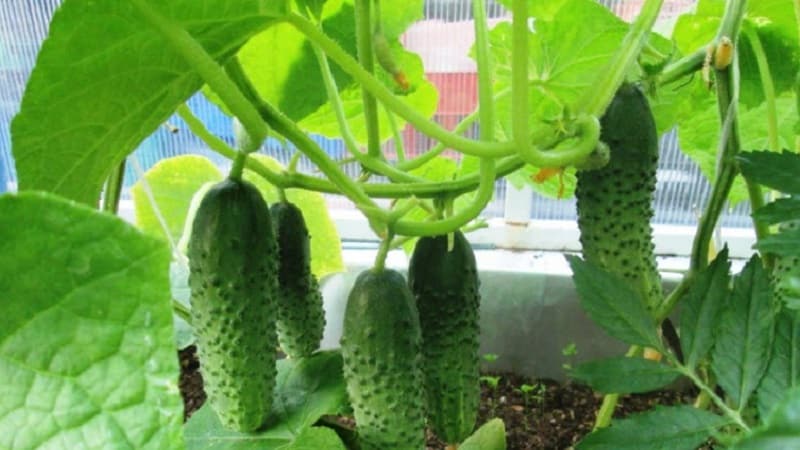
Planting by seedlings
No hybrid seeds needed disinfect, soak in growth stimulants and germinate, the manufacturer takes care of this. The promised germination rate is 100%.
Seedlings react painfully to transplantation, so the seeds are placed in 500 ml peat pots. The soil is prepared from humus, peat and sawdust in a ratio of 2:2:1. Fill with a strong solution of potassium permanganate for disinfection and add 25 g of superphosphate.
Containers are filled with damp soil, plant the seeds to a depth of 1 cm and sprinkle with a layer of peat. Polyethylene is stretched over the top and placed in a warm, dark place.
After emergence The film is removed and the pots are placed in a sunny place.
Watering - plentiful, once every seven days.
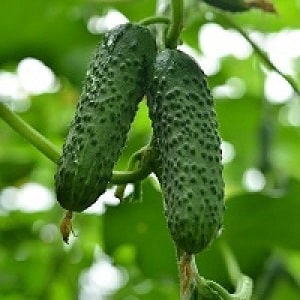 Seedlings feed once a week ready-made liquid fertilizers “Kemira”, “Aquarin”, “Fertika”.
Seedlings feed once a week ready-made liquid fertilizers “Kemira”, “Aquarin”, “Fertika”.
At the age of 20 days, after the formation of three true leaves, the seedlings are transferred to a permanent place.
Herman hybrid bushes are determinate, spreading, with a powerful rhizome. Therefore, for unhindered development when planting in rows, there must be a distance of at least 30 cm between plants. The gap between rows is 60 cm.
Reference. Farmers note that the yield of the German hybrid increases significantly when planted at a distance of 40 cm.
Growing stages and care
Rules for successful cultivation of cucumbers:
- Watering is frequent but moderate, at least once every three days.
- Root and foliar feeding - at least three times per season.
- Loosening the soil after watering.
- Regular weeding.
- Forming bushes and tying vines to the trellis.
- Timely harvesting.
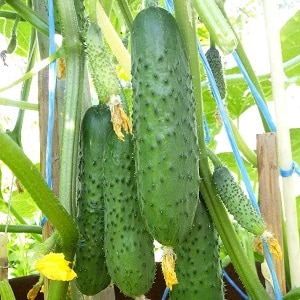 Feeding scheme:
Feeding scheme:
- first (organic) – 14-15 days after planting;
- the second (mineral) - during flowering;
- third (mineral) – during fruiting;
- the fourth (mineral) - to increase the harvest period and greater crop productivity.
Reference. An excess of nitrogen in the soil reduces the number of ovaries.
Organic root feeding options:
- solution of quail or chicken droppings 1:15;
- infusion of green fertilizers (cut grass or tops) 1:5;
- cow dung solution 1:6.
Options for root mineral supplements (per 10 liters of water):
- urea 1 tbsp. l., superphosphate 60 g;
- ammonium nitrate 10 g, superphosphate 10 g, potassium salt 10 g;
- potassium nitrate 20 g, ammonium nitrate 30 g, superphosphate 40 g;
- wood ash 200 g.
Foliar feeding:
- superphosphate 25 g/10 l;
- boric acid 1 tsp, potassium permanganate on the tip of a knife/1 l;
- urea 15 g/10 l.
Features of cultivation and possible difficulties
Due to the tendency of cucumbers to overgrow, the plant has bunched ovaries requires mandatory shaping of the bush and timely harvesting.
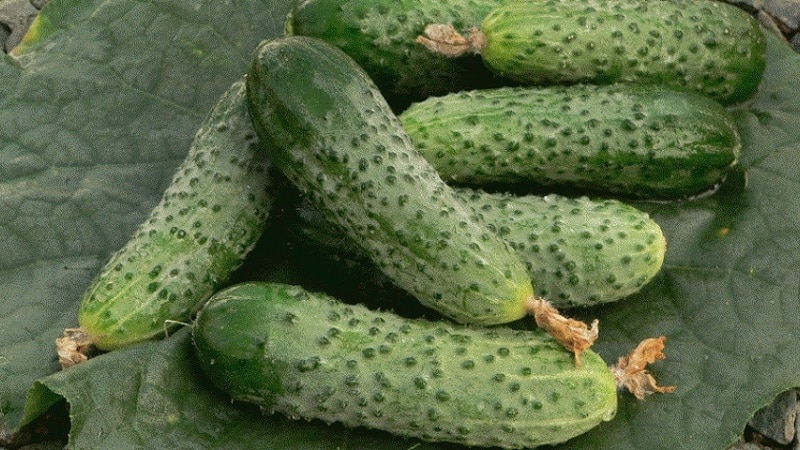
Forming rules:
- all flowers and shoots formed from the axils of the leaves are removed;
- one ovary is left in the axils of the fifth leaf;
- two ovaries are left in the axils of 7-10 leaves;
- the stem is thrown over the trellis;
- The top is pinched 1 m from the ground.
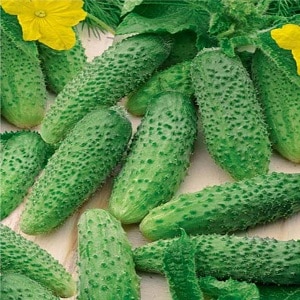 For irrigation, use only warm rain or settled water., otherwise the cucumbers will get sick and lose their taste.When the soil temperature is below +12 °C, the frequency of watering is reduced. The root system slowly absorbs nutrients and moisture.
For irrigation, use only warm rain or settled water., otherwise the cucumbers will get sick and lose their taste.When the soil temperature is below +12 °C, the frequency of watering is reduced. The root system slowly absorbs nutrients and moisture.
To get a second wave of harvest, starting from mid-August, the bushes are hilled to stimulate the formation of additional roots, yellowed and dry leaves are removed, foliar feeding is used - 1 liter of whey, 30 drops of iodine.
Diseases and pests
The hybrid is resistant to cucumber mosaic virus and powdery mildew, but is tolerant to fungi that cause rust. This is not a separate disease, but a whole group with the same symptoms (anthracnose, cladosporiosis, ascochyta blight).
Signs:
- small yellow spots on the front side of the leaves at the initial stage;
- brown spots in the acute phase;
- dryness of leaves and stems.
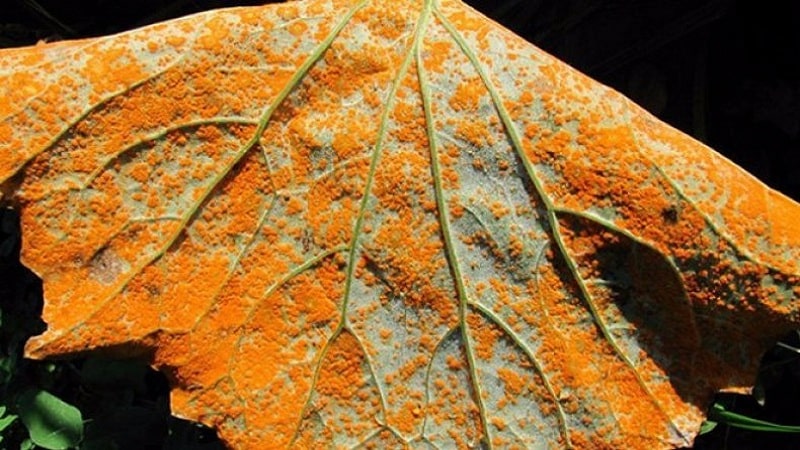
Prevention and treatment:
- molding plants into 1 stem;
- removal of infected leaves and shoots;
- treatment with a 1% solution of Bordeaux mixture, infusion of wood ash (300 g per 10 l), soap solution (50 g of shavings per 10 l of water).
Spraying bushes carried out once a week.
The most common pests of cucumbers – spider mites, aphids and root-knot nematodes.
Fight aphids ladybugs help. Experienced farmers advise planting marigolds, calendula, dill, and mustard near beds with cucumbers to attract them. Since aphids become active at the height of harvest, the use of insecticides is unacceptable.

Folk remedies will come to the rescue:
- 300 g tobacco shag/10 liters of boiling water;
- 100 g onion peel/1 liter of warm water, after 48 hours, increase the volume to 5 liters;
- 200 g of garlic arrows / 1 liter of water, after five days the product is ready;
- 100 g of laundry soap shavings/10 liters of water.
Solutions are used for spraying bushes once a week.
Spider mite most often affects plantings in greenhouses. To combat the pest, infusions of yarrow, celandine, and dandelion are used. Finely chopped grass is placed in a bucket and filled to the top with water. After 3-4 days the product is ready for use.
Root-knot nematodes can cause serious damage cucumber plantings. The pest penetrates the root system and releases toxic substances. As a result, growths and swellings appear on them, in which larvae develop. This leads to stunted growth and reduced yield.
To prevent infection In the fall, a 50 cm layer of soil is removed. Greenhouses are disinfected with steam, and in winter the soil is frozen. In spring, the soil is treated with Fitoverm or Actofit. Cucumbers in the growing season are irrigated with the following preparations: Aldoxycarb, Marshall, Carbofuran, Alanicarb.
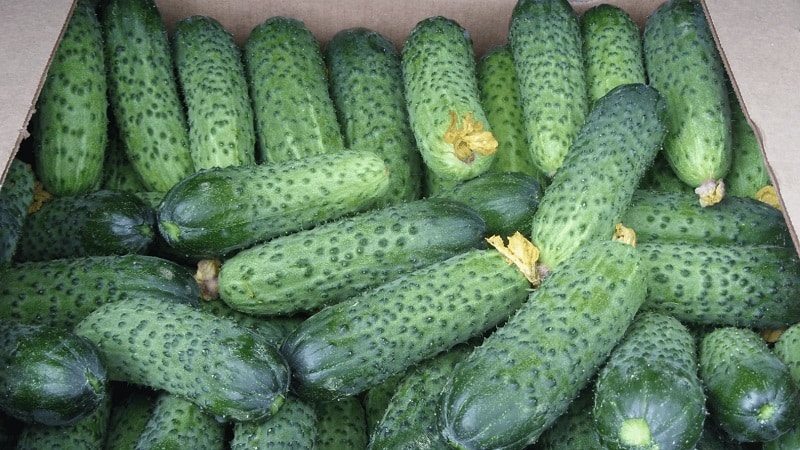
Harvesting and application
Zelentsy begin to be harvested 36-40 days after full germination – once every two days. This guarantees long and abundant fruiting.
Harvesting is carried out in the morning or evening. Bundle-type fruits are not broken off, but cut with scissors, trying not to touch the young ovaries. Cucumbers are used to make salads, pickling And pickling.
Shelf life of collected products in a cool place - no more than a week.
Advantages and disadvantages
The table summarizes the advantages and disadvantages of the hybrid Hermann.
| Advantages | Flaws |
| Early ripeness | Seedlings react poorly to transplantation and low temperatures |
| High productivity | Cucumbers are prone to rust |
| Evenness of Zelentsy | The need to shape bushes |
| Resistance to viruses and bacteria | |
| Great taste without bitterness | |
| Versatility of use in cooking | |
| No need for additional pollination | |
| High level of transportation |
Reviews
The Dutch hybrid Herman was highly praised by gardeners for low maintenance, high yield and excellent taste.
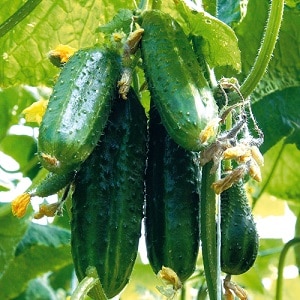 Andrey, Ryazan: “I have been growing the hybrid in a greenhouse for four years in a row. Cucumbers have a pleasant, refreshing, slightly sweet taste. The pulp is medium density, without voids. The plant is sensitive to decreased daylight hours, and already in mid-September the yield decreases. Last year I installed phytolamps and am harvesting fruits until the end of November.”.
Andrey, Ryazan: “I have been growing the hybrid in a greenhouse for four years in a row. Cucumbers have a pleasant, refreshing, slightly sweet taste. The pulp is medium density, without voids. The plant is sensitive to decreased daylight hours, and already in mid-September the yield decreases. Last year I installed phytolamps and am harvesting fruits until the end of November.”.
Elena, Pavlovo: “I grew cucumbers the year before last through seedlings. The seeds were sown immediately in peat pots. The seedlings have taken root by 80%. Last year I decided to sow directly into the ground. The seedlings sprouted thickly, strong and strong. Caring for a crop is as easy as shelling pears, the main thing is to form the bushes correctly to get a rich harvest.”.
Ivan, Kovrov: “Herman is one of the best hybrids for indoor soil. I was convinced of this from my own experience. I haven’t bought any other seeds for five years now. I grow cucumbers for personal consumption. I use it for salads, pickling and pickling. The fruits are juicy, aromatic, sweet, do not taste bitter, and do not soften in the jar.”.
Conclusion
The hybrid Herman cucumber, popular among summer residents and large farmers, has held the palm for several years in a row. The culture is undemanding to care and only requires abundant watering, fertilizing and shaping the bush. The plant is immune to tobacco mosaic virus and powdery mildew. If you follow the rules of agricultural technology and preventive treatments with copper-containing preparations, you rarely suffer from cucumber rust.
Excellent sweetish taste, juicy, medium-density pulp without bitterness or voids allow greens to be widely used in cooking.